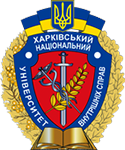Countering hostile sabotage and reconnaissance groups by the National Police of Ukraine units in the context of martial law
Abstract
The article is devoted to the study of ways to improve the tactical and special readiness of police officers to counteract sabotage and reconnaissance groups in the border areas and in the areas of active hostilities. The author identifies additional powers of the police under the martial law regime, including the following: conducting joint operations against sabotage and reconnaissance forces of the aggressor (enemy) and paramilitary or armed groups which are not regulated by the laws of Ukraine.
To address the objectives of the study, the analysis of the sources of international and national law providing for the use of sabotage and reconnaissance groups by the parties to the conflict is carried out, the essence and hierarchical structure of these groups are revealed, and the objects against which the use of sabotage measures is prohibited are identified. The article also provides a list of objects of the warring parties which, according to international humanitarian law, may be subject to damage.
The organisational features of the basics for defensive combat by the units of the ground forces of certain countries, in particular, the Federal Republic of Germany and the United States of America, are considered. According to the military doctrine of these countries, the purpose of defence is to disrupt the enemy’s offensive actions, inflict maximum losses in manpower and equipment, and gain time to concentrate forces in the chosen direction for the offensive.
The article describes the signs that can be used to identify members of Russian sabotage and reconnaissance groups. These signs are the following: the execution of certain actions, including conducting intelligence activities, destabilising the situation by committing criminal offences (explosions, murders, assaults, robberies) under the guise of domestic crimes, spreading false information and discrediting the authorities during direct communication with the local population.
The tactical methods of combating sabotage and reconnaissance groups in the territory of the controlled border area are highlighted. The experience of counter-sabotage measures by the security and defence forces of Ukraine, one of the elements of which is an ambush, is studied.
A model of sabotage protection and its use in the educational process of higher education institutions of the Ministry of Internal Affairs of Ukraine is proposed, which provides for a comprehensive combination of command and staff exercises with tactical and special exercises in two stages and involvement of cadets in ensuring public safety and order in border settlements.
Downloads
References
Borovyk, M. O. (2021). Improvement of stress resistance of police officers during combat missions of the Joint Forces Operations through physical training. Pedagogical Sciences: Theory and Practice, 2(38), 112–120. https://doi.org/10.26661/2522-4360-2021-2-18.
Borovyk, M. O., Shutiak, I. A., Larionova, I. T., & Ishenkov, M. V. (2023). Personal security of a police officer in the conditions of the legal regime of martial law. WRITINGS.
Kovalev, I., Borovyk, M., Kushnirenko, R., Kolesnikov, V., & Koval, A. (2022). On the issues of education of psychological resistance of future police officers under the conditions of marital state in the process of professional training. Science and Technology Today, 12(12), 128–138. https://doi.org/10.52058/2786-6025-2022-12(12)-128-137.
Kuzmenko, Iu. V., Koropatov, O. M., & Dumanskyi, R. V. (2022). Administrative and legal ensuring the protection of critical infrastructure objects in Ukraine during marital state. Law Bulletin, 27, 59–65. https://doi.org/10.32850/LB2414-4207.2022.27.08.
Larsen, K. (2022). Light Infantry Tactics for Small Teams (A. Pylypenko, M. Fediai, N. Meleshkova et al., Transl.). Our format.
Mysyk, A., & Andrushko, O. (2020). Model of identification of diversion and intelligence group at attempt to cross the state border. Collection of Scientific Works of the National Academy of the State Border Guard Service of Ukraine, 83(2), 190–203. https://doi.org/10.32453/3.v83i2.567.
Pichuhin, M. F., Yermakov, V. O., & Cherniaiev, S. I. (2006). Intelligence training. Part I. Basics of military intelligence. ZhVIRE.
Poltorak, S. T., Tkachenko, M. D., Lysenko, O. V. et al. (2012). General tactics. Part 1. KhUPS.
Poltsev, I., Khaustov, D., Tymchuk, O. et al. (2022). Fight against illegal armed formations during the stabilization operations of the troops. National Academy of Ground Troops.
Shynkarenko, I., & Podzolkova, T. (2022). Legal and methodological problems regarding the identification of members of russian diversion and intelligence groups during the military invasion. Scientific Bulletin of the Dnipropetrovsk State University of Internal Affairs, 2, 21–28. https://doi.org/10.31733/2078-3566-2022-2-21-28.
Sniehirov, D. (2022, March 12). How to recognize and neutralize a Russian DIG: key signs of saboteurs and what to do in case of meeting them. CHAS.NEWS. https://chas.news/current/yak-rozpiznati-i-zneshkoditi-rosiisku-drg-klyuchovi-oznaki-diversantiv-ta-scho-robiti-u-razi-zustrichi-z-nimi.
Yasko, V. A., Osadchyi, O. M., & Yasko, O. V. (2015). Improvised explosive devices and combating them. Part 1. Actions of units in conditions of use of improvised explosive devices. Ivan Ohiienko K-PNU.
Yermakov, V. O., Cherniaiev, S. I., & Vinnyk, V. I. (2010). Intelligence training. Part II. Basics of organizing and conducting intelligence by units. ZhVI NAU.
Zaitsev, D. V., Nakonechnyi, A. P., Pakhariev, S. O., & Lutsenko, I. O. (2016). Military intelligence (V. B. Dobrovolskyi, Ed.). Kyiv University Publishing and Printing Center.
Zelenyi, V. I. (2011). General tactics. Publisher of Palyvoda A. V.
Copyright (c) 2024 M. O. Borovyk

This work is licensed under a Creative Commons Attribution 4.0 International License.



